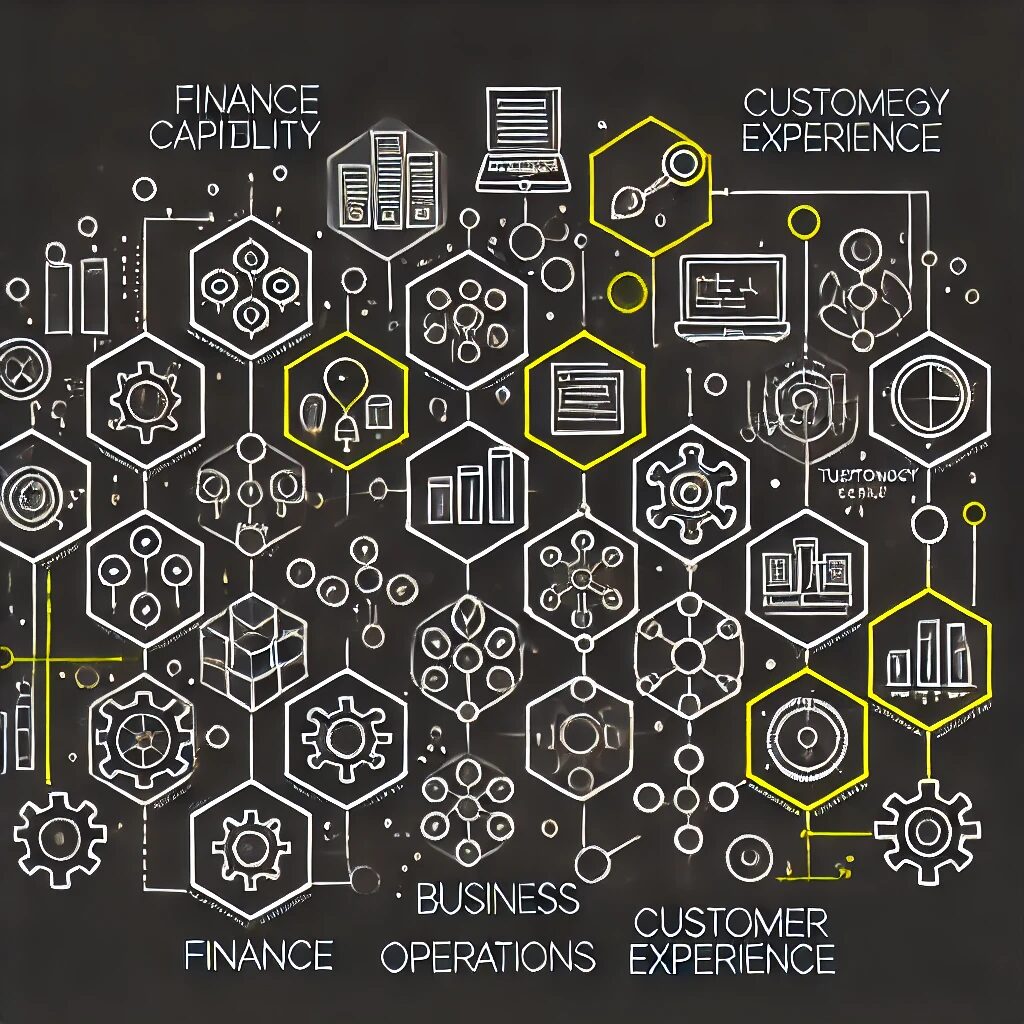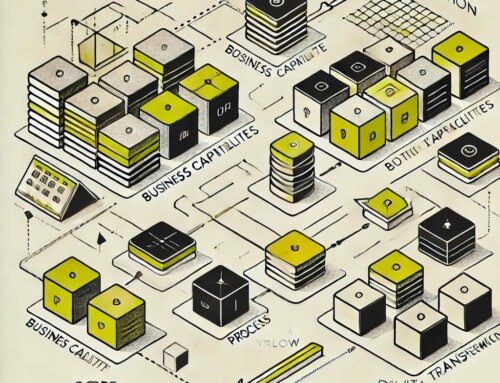
Building a Utility-Focused Business Capability Map. From Grid to Customer: Mapping the Core of Your Utility Enterprise
In today’s rapidly evolving utilities landscape, understanding your organization’s business capabilities is no longer optional—it’s essential. As regulatory pressures mount, customer expectations evolve, and the transition to sustainable energy accelerates, utilities must clearly understand what they do, how well they do it, and where they need to invest. A comprehensive business capability map provides this critical foundation.
A business capability map defines what your utility does (or should do) independent of how you do it. By creating this structured inventory of your enterprise capabilities, you establish a powerful tool for strategic planning, technology investment, and organizational transformation that speaks a language both business and technology stakeholders understand.
1: The Strategic Value of Capability Mapping for Utilities
Capability mapping provides utilities with a stable, business-focused view of the enterprise that transcends organizational structures, technologies, and short-term initiatives. This foundation enables more strategic decision-making across the organization.
- Strategic Alignment: A capability map creates direct links between business strategy and the operational abilities needed to execute it, ensuring investments align with strategic priorities.
- Common Language: Capability maps establish a shared vocabulary that bridges communication gaps between business units, operations teams, and technology organizations.
- Investment Prioritization: By assessing capability performance against strategic importance, utilities can more effectively allocate limited resources to high-impact areas.
- Technology Planning: Capability maps provide the business context for technology roadmaps, ensuring IT investments deliver meaningful business outcomes.
- Organizational Design: Capability perspectives help utilities design organizational structures that optimize the delivery of critical capabilities rather than reinforcing traditional silos.
2: Core Components of a Utility Capability Map
A comprehensive utility capability map encompasses several levels of detail, organized hierarchically to balance strategic perspective with operational specificity.
- Capability Domains: Top-level groupings that organize capabilities into logical categories such as Grid Operations, Customer Experience, or Energy Supply.
- Level 1 Capabilities: Primary business functions that define what the utility does, such as Distribution Management, Customer Enrollment, or Regulatory Compliance.
- Level 2 Capabilities: More granular decomposition of Level 1 capabilities that provide additional specificity without becoming implementation-dependent.
- Capability Attributes: Metadata associated with each capability, such as strategic importance, current performance, process linkages, and supporting applications.
- Capability Relationships: Defined connections between capabilities that show dependencies, information flows, and service relationships.
3: Utility-Specific Capability Domains
While industry-standard frameworks provide starting points, utility capability maps should reflect the unique characteristics and priorities of the energy sector.
- Grid Operations: Capabilities related to managing the physical electricity or gas delivery infrastructure, from asset management to outage response.
- Energy Supply: Capabilities for energy generation, procurement, trading, and portfolio management to ensure reliable supply.
- Customer Experience: Customer-facing capabilities from enrollment and billing to service delivery and support across channels.
- Product & Service Management: Capabilities for developing, managing, and retiring utility products and services, including rate design.
- Regulatory Management: Capabilities for navigating complex regulatory environments, including compliance, rate cases, and stakeholder management.
Did You Know:
- According to a 2024 utility industry benchmark study, 76% of utilities with documented capability maps reported improved alignment between business and IT investment priorities, compared to just 23% of utilities without capability maps.
4: Grid Operations Capability Examples
Grid Operations capabilities focus on the management, maintenance, and optimization of physical infrastructure that delivers energy to customers.
- Asset Management: Capabilities for planning, acquiring, maintaining, and optimizing the utility’s physical asset portfolio throughout its lifecycle.
- Network Operations: Real-time monitoring, control, and optimization of the distribution or transmission network to ensure reliable service delivery.
- Outage Management: Capabilities for detecting, responding to, and restoring service during planned and unplanned outages.
- Field Service Management: Capabilities for scheduling, dispatching, and supporting field workers performing installation, maintenance, and repair activities.
- Distributed Resource Integration: Capabilities for integrating customer-owned generation, storage, and flexible load resources into grid operations.
5: Customer Experience Capability Examples
Customer Experience capabilities focus on acquiring, serving, and retaining customers across all touchpoints and channels.
- Customer Acquisition: Capabilities for identifying, engaging, and enrolling new utility customers or expanding services to existing customers.
- Billing & Revenue Management: Capabilities for meter-to-cash processes, including consumption calculation, bill generation, payment processing, and collections.
- Service Management: Capabilities for managing service requests, appointments, and issue resolution across customer touchpoints.
- Digital Engagement: Capabilities for providing self-service, information, and transactions through digital channels.
- Customer Insight: Capabilities for gathering, analyzing, and applying customer data to improve experiences and operations.
6: Methodology for Building Your Capability Map
Creating an effective utility capability map requires a structured approach that balances industry standards with your organization’s unique characteristics.
- Research & Benchmarking: Begin by researching industry reference models and benchmarking against peer utilities to establish a capability foundation.
- Stakeholder Engagement: Involve diverse stakeholders from across the organization to validate capabilities and build ownership of the resulting map.
- Iterative Development: Develop the capability map iteratively, starting with Level 1 capabilities before diving into more detailed decomposition.
- Validation Workshops: Conduct structured workshops to validate capability definitions, relationships, and hierarchies with subject matter experts.
- Documentation Standards: Establish clear standards for capability definitions, ensuring consistent terminology and appropriate level of detail.
7: Assessing Capability Maturity & Performance
Capability assessment transforms a static map into a dynamic tool for investment planning and transformation.
- Assessment Dimensions: Define key dimensions for evaluating capabilities, such as performance, strategic importance, risk exposure, and digital maturity.
- Measurement Methodology: Establish consistent measurement approaches that combine quantitative metrics with qualitative expert assessment.
- Heat Mapping: Visualize assessment results through heat maps that highlight capability gaps and investment priorities.
- Benchmarking: Compare capability performance against industry peers and best practices to identify significant gaps.
- Portfolio Analysis: Group capabilities by assessment results to create investment portfolios, such as “maintain,” “enhance,” or “transform.”
8: Using Capability Maps for Strategic Planning
A well-designed capability map becomes a powerful tool for connecting enterprise strategy to execution planning.
- Strategy Translation: Use capability mapping to translate strategic objectives into specific capability requirements and performance targets.
- Gap Analysis: Identify gaps between current and required capability performance to achieve strategic goals.
- Investment Roadmapping: Sequence capability investments based on strategic priorities, dependencies, and organizational capacity.
- Scenario Planning: Use capability perspectives to evaluate different strategic scenarios and their implementation requirements.
- Performance Tracking: Monitor capability performance improvement over time to validate strategic investments and adjust plans as needed.
9: Capability-Based Technology Planning
Capability maps provide a business-focused foundation for more effective technology planning and portfolio management.
- Application Portfolio Mapping: Map existing applications to business capabilities to identify redundancies, gaps, and rationalization opportunities.
- Technology Roadmapping: Develop technology roadmaps that align with capability investment priorities and sequencing.
- Build vs. Buy Decisions: Use capability analysis to make more informed decisions about internal development versus external solutions.
- Data Architecture Alignment: Align data architecture efforts with capability needs, ensuring critical data assets support high-priority capabilities.
- Integration Planning: Identify integration requirements based on information flows between interdependent capabilities.
10: Organizational Design Applications
Capability maps provide a valuable perspective for designing more effective organizational structures.
- Capability-Based Structure: Design organizational units around cohesive capability groupings rather than traditional functional silos.
- Role Definition: Use capability models to define key roles and responsibilities for delivering and governing critical capabilities.
- Skills Assessment: Identify skill requirements and gaps based on capability needs and transformation priorities.
- Governance Design: Establish governance structures that align with capability domains and their interdependencies.
- Change Impact Analysis: Use capability maps to identify organizational impacts of transformation initiatives and plan change management accordingly.
11: Accelerating Time-to-Value with Pre-Built Capability Maps
Pre-built utility capability maps provide a significant head start, allowing you to customize rather than create from scratch.
- Rapid Foundation: Starting with an industry-specific capability model reduces initial development time by up to 70%, allowing you to focus on utility-specific customization and value-adding activities.
- Best Practices Integration: Pre-built maps incorporate industry best practices and benchmarks, ensuring your capability foundation reflects current industry standards.
- Common Taxonomy: Established capability frameworks provide standardized terminology that facilitates communication with vendors, partners, and industry peers.
- Implementation Accelerators: Leading pre-built maps include implementation tools like assessment templates, RACI matrices, and technology mapping guides.
- Regular Updates: Quality pre-built maps receive periodic updates to incorporate emerging capabilities and industry trends, ensuring your model remains current.
Did You Know:
- Utilities with capability-based technology planning report 31% higher business satisfaction with IT outcomes and 24% lower technology total cost of ownership compared to those using traditional project-based approaches, according to a 2023 industry study.
12: Customizing a Pre-Built Map for Your Utility
While pre-built maps provide an excellent starting point, thoughtful customization ensures the map reflects your utility’s unique characteristics.
- Capability Relevance: Review each capability to determine relevance to your organization, adding utility-specific capabilities and removing irrelevant ones.
- Terminology Alignment: Adjust terminology to match your organization’s vocabulary, ensuring stakeholders recognize and relate to capability descriptions.
- Depth Calibration: Adjust the level of detail for different capability areas based on strategic importance and transformation priorities.
- Relationship Mapping: Define key relationships between capabilities that reflect your utility’s unique operating model and value streams.
- Attribute Definition: Add utility-specific attributes that provide context relevant to your organization’s strategic priorities and challenges.
13: Getting Started with Your Capability Map
A successful capability mapping initiative requires proper preparation, sponsorship, and scope management.
- Executive Sponsorship: Secure executive sponsorship from both business and technology leadership to ensure organizational commitment.
- Scope Definition: Clearly define the scope of your initial capability mapping effort, potentially starting with high-priority domains.
- Team Assembly: Form a cross-functional team with representation from business, operations, and technology to develop the capability map.
- Success Metrics: Establish clear success criteria for your capability mapping initiative, focusing on business outcomes rather than deliverable completion.
- Communication Plan: Develop a communication strategy to build awareness and engagement with the capability mapping effort across the organization.
14: Capability Map Governance and Maintenance
Establishing effective governance ensures your capability map remains relevant and valuable over time.
- Ownership Definition: Assign clear ownership for the capability map at the enterprise level and individual capability domains.
- Change Management Process: Establish a defined process for requesting, evaluating, and implementing changes to the capability map.
- Review Cadence: Schedule regular reviews of the capability map to ensure ongoing alignment with business strategy and industry evolution.
- Integration with Other Practices: Connect capability map governance with related practices such as enterprise architecture, portfolio management, and strategic planning.
- Capability Community: Foster a community of practice around capability-based approaches to build skills and share best practices.
Takeaway
A well-designed business capability map provides utilities with a stable, business-focused view of the enterprise that transcends organizational structures, technologies, and short-term initiatives. By documenting what your utility does—independent of how you do it—you create a powerful tool for strategic alignment, investment prioritization, and transformation planning. While building a comprehensive capability map requires effort, starting with industry-specific frameworks significantly accelerates the process while ensuring alignment with utility best practices. The resulting capability perspective enables more strategic decision-making across the organization, from technology investments to organizational design to regulatory strategy.
Next Steps
- Assess Your Starting Point: Evaluate existing capability documentation, process models, and organization charts to identify elements that can inform your capability map development.
- Secure Executive Sponsorship: Engage executive leadership to ensure understanding of the strategic value of capability mapping and commitment to the effort.
- Define Initial Scope: Determine whether to develop an enterprise-wide map or focus initially on high-priority capability domains based on strategic initiatives.
- Consider Accelerators: Evaluate pre-built utility capability maps as a foundation to accelerate development and incorporate industry best practices.
- Form a Cross-Functional Team: Assemble a team with diverse expertise across business domains, operations, and technology to develop and validate the capability map.
- Plan for Sustainability: Design governance and maintenance processes to ensure the capability map remains relevant and valuable as your utility evolves.



